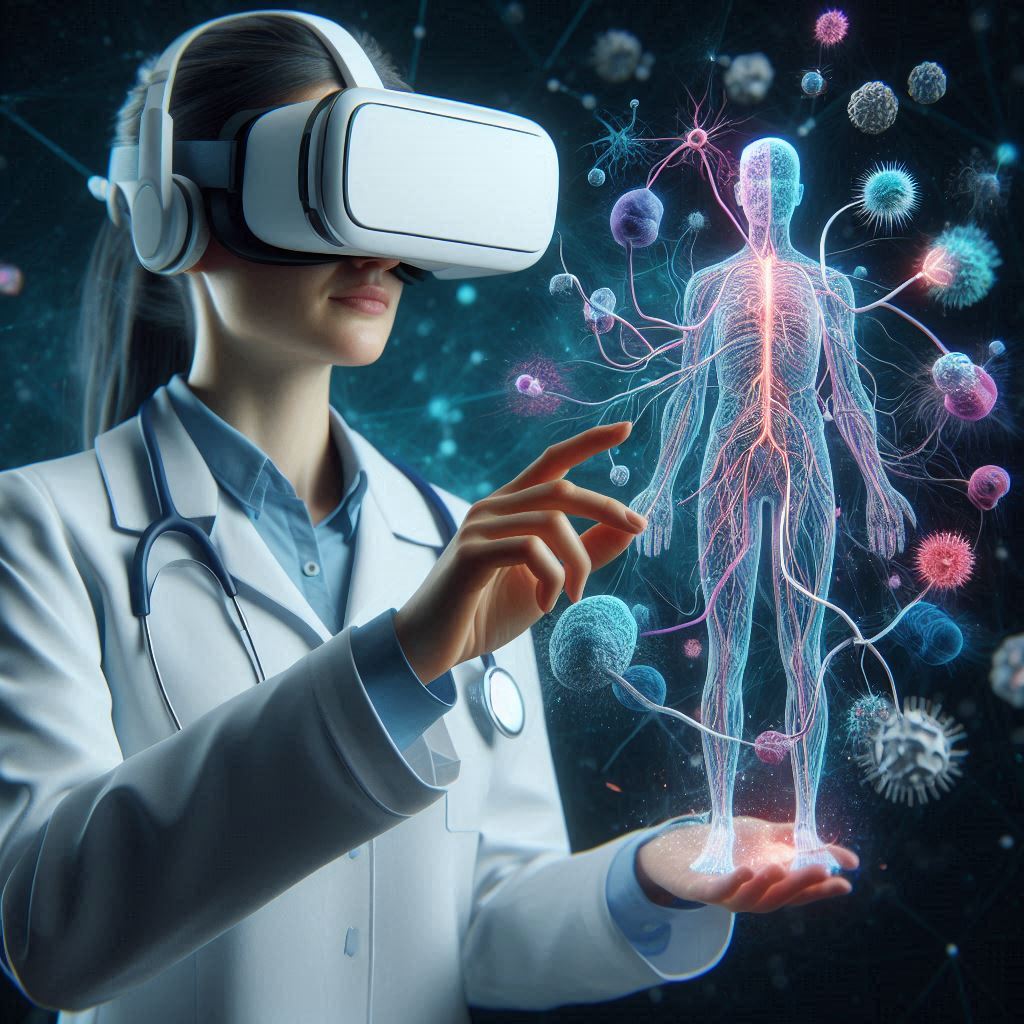Introduction
In 2023, over 200 million smart wearables were sold worldwide.
This surge reflects a growing trust in technology for health monitoring.
Smart wearables have rapidly evolved, offering new ways to track and improve health.
These devices are not just trends; they represent a significant shift in personal healthcare.
The Revolution of Health Monitoring
Smart wearables revolutionize health monitoring by providing real-time data.
These devices offer continuous insights into various health metrics, transforming how we understand our bodies.
From tracking steps to monitoring heart rates, they offer a comprehensive view of health.
Key Points Covered
- The Evolution of Health Monitoring:
- Traditional methods and their limitations
- The rise of smart wearables
- Traditional methods and their limitations
- Types of Smart Wearables:
- Fitness trackers
- Smartwatches
- Specialized health wearables
- Fitness trackers
- Features and Benefits:
- Continuous monitoring
- Data analysis and insights
- Early detection and prevention
- User convenience
- Continuous monitoring
- Impact on Healthcare Industry:
- Patient empowerment
- Telemedicine and remote monitoring
- Data-driven healthcare
- Patient empowerment
- Challenges and Considerations:
- Data privacy and security
- Accuracy and reliability
- Accessibility and cost
- Data privacy and security
- Future of Smart Wearables:
- Technological advancements
- Integration with other technologies
- Expanding use cases
- Technological advancements
Smart wearables are transforming health monitoring by offering personalized, real-time insights.
These devices empower users and revolutionize the healthcare industry.
This blog post will explore their evolution, types, features, benefits, impact, challenges, and future potential.
Stay tuned to learn how smart wearables can enhance your health journey.
The Evolution of Health Monitoring
Traditional Methods
Health monitoring has a long history of traditional methods.
People have relied on regular doctor visits for health check-ups.
Physicians would measure vital signs and perform physical examinations.
Patients also manually recorded their health data.
They used journals to track symptoms, diet, and exercise.
Traditional methods included:
- Doctor Visits: Regular appointments to assess health.
- Manual Recording: Using journals to log health data.
- Physical Examinations: Doctors measured vitals and conducted exams.
While these methods were essential, they had significant limitations.
Doctor visits occurred sporadically, missing many health changes.
Manual recording was often inconsistent and prone to errors.
People could forget to log important details or misinterpret their symptoms.
Physical examinations provided only a snapshot of health at one point in time.
They did not offer continuous monitoring of vital signs.
Limitations of Traditional Methods
- Infrequent Monitoring:
- Doctor visits happened only a few times a year.
- Changes in health between visits were often missed.
- Doctor visits happened only a few times a year.
- Inconsistency:
- Patients often forgot to record their health data.
- Manual logs were prone to errors and omissions.
- Patients often forgot to record their health data.
- Snapshot Data:
- Physical exams provided only momentary health information.
- Continuous monitoring was not possible.
- Physical exams provided only momentary health information.
Rise of Smart Wearables
Smart wearables began to emerge as technology advanced.
Early devices focused on basic fitness tracking.
The first generation of wearables included pedometers and simple activity trackers.
These devices measured steps and estimated calories burned.
A brief history of the development of smart wearables:
- 1970s: Early pedometers measured steps but lacked advanced features.
- 1980s: Heart rate monitors were introduced for athletes.
- 1990s: Wearable fitness trackers became popular, focusing on steps and basic activity.
In the early 2000s, wearables started integrating more sophisticated technology.
They began to include sensors for heart rate, sleep, and movement.
The introduction of Bluetooth allowed wearables to sync data with smartphones and computers.
This advancement made it easier to track and analyze health data over time.
Examples of Early Smart Wearables
- Pedometers:
- Early devices focused on counting steps.
- They provided basic insights into daily activity levels.
- Early devices focused on counting steps.
- Heart Rate Monitors:
- Initially used by athletes to track workout intensity.
- Helped users optimize their fitness routines.
- Initially used by athletes to track workout intensity.
- Basic Activity Trackers:
- Devices like the Fitbit Classic tracked steps and calories.
- They laid the groundwork for more advanced wearables.
- Devices like the Fitbit Classic tracked steps and calories.
Evolution of Features
As technology progressed, smart wearables evolved rapidly.
They started offering real-time health data and personalized insights.
Modern wearables include advanced sensors for various health metrics.
Put Your Tech Company on the Map!
Get featured on Nicholas Idoko’s Blog for just $50. Showcase your business, boost credibility, and reach a growing audience eager for tech solutions.
Publish NowThey can monitor heart rate variability, sleep stages, and blood oxygen levels.
Key advancements in smart wearables:
- Real-Time Monitoring:
- Continuous tracking of vital signs and activity levels.
- Immediate feedback on health status.
- Continuous tracking of vital signs and activity levels.
- Personalized Insights:
- Analysis of data to provide customized health recommendations.
- Alerts for abnormal readings or potential health issues.
- Analysis of data to provide customized health recommendations.
- Integration with Other Devices:
- Syncing with smartphones and health apps.
- Seamless data sharing with healthcare providers.
- Syncing with smartphones and health apps.
The evolution from traditional methods to smart wearables marks a significant leap in health monitoring.
Traditional methods provided essential but limited insights.
Smart wearables offer continuous, real-time data and personalized health insights.
This shift has transformed how we understand and manage our health.
As technology continues to advance, smart wearables will play an even more crucial role in health monitoring.
They promise to make health management more proactive and personalized, improving overall well-being.

Types of Smart Wearables for Health Monitoring
Fitness Trackers
Fitness trackers have become a staple in health monitoring.
These devices track steps, monitor heart rates, and measure sleep patterns.
Fitness trackers help users maintain an active lifestyle by providing real-time feedback on their activity levels.
They offer a simple, user-friendly interface that encourages daily use.
Functions of Fitness Trackers:
- Step Counting:
- Tracks the number of steps taken daily.
- Encourages users to reach step goals.
- Tracks the number of steps taken daily.
- Heart Rate Monitoring:
- Measures heart rate throughout the day.
- Provides insights into cardiovascular health.
- Measures heart rate throughout the day.
- Sleep Tracking:
- Monitors sleep duration and quality.
- Helps users improve their sleep habits.
- Monitors sleep duration and quality.
Popular brands and models dominate the market. Fitbit offers a range of models like the Charge and Inspire series.
Garmin’s Vivosmart series is also popular for fitness tracking. Xiaomi’s Mi Band provides a budget-friendly option with comprehensive features.
Smartwatches
Smartwatches have taken health monitoring to the next level.
These devices offer advanced features beyond basic fitness tracking.
Smartwatches include ECG monitoring, SpO2 tracking, and stress analysis.
They provide a holistic view of health by integrating multiple sensors and functionalities.
Advanced Features of Smartwatches:
- ECG Monitoring:
- Records electrocardiogram data.
- Detects irregular heart rhythms.
- Records electrocardiogram data.
- SpO2 Tracking:
- Measures blood oxygen saturation levels.
- Monitors respiratory health.
- Measures blood oxygen saturation levels.
- Stress Analysis:
- Assesses stress levels using heart rate variability.
- Provides relaxation techniques.
- Assesses stress levels using heart rate variability.
Smartwatches seamlessly integrate with smartphones and health apps.
They sync data with apps like Apple Health and Google Fit.
This integration allows users to analyze their health data comprehensively.
Notifications and alerts from smartwatches keep users informed about their health status.
Popular smartwatches include the Apple Watch Series, Samsung Galaxy Watch, and Garmin Fenix series.
These models offer a range of features to cater to different health monitoring needs.
Specialized Health Wearables
Specialized health wearables cater to specific medical conditions.
These devices provide targeted monitoring and management for particular health issues.
Glucose monitors help diabetics track blood sugar levels continuously.
Sleep trackers analyze sleep stages and detect disorders like sleep apnea.
Types of Specialized Health Wearables:
- Glucose Monitors:
- Continuously track blood sugar levels.
- Help diabetics manage their condition.
- Continuously track blood sugar levels.
- Sleep Trackers:
- Monitor sleep stages and quality.
- Detect sleep disorders and provide insights.
- Monitor sleep stages and quality.
- Blood Pressure Monitors:
- Measure blood pressure throughout the day.
- Help manage hypertension.
- Measure blood pressure throughout the day.
- Wearable ECG Monitors:
- Provide continuous ECG readings.
- Detect cardiac anomalies.
- Provide continuous ECG readings.
These wearables cater to specific medical needs by offering precise monitoring.
Glucose monitors, for example, provide real-time glucose levels.
They alert users to highs and lows, helping them maintain stable blood sugar.
Sleep trackers provide detailed sleep analysis, helping users improve sleep quality and address disorders.
Popular specialized health wearables include the Dexcom G6 for glucose monitoring.
The Oura Ring provides comprehensive sleep and activity tracking.
The Withings BPM Connect is popular for blood pressure monitoring.
Put Your Tech Company on the Map!
Get featured on Nicholas Idoko’s Blog for just $50. Showcase your business, boost credibility, and reach a growing audience eager for tech solutions.
Publish NowSmart wearables diversify health monitoring, making it more accessible, personalized, and effective.
These devices will continually enhance our health management.
Key Features and Benefits of Smart Wearables
Continuous Monitoring
Smart wearables provide continuous health monitoring, which revolutionizes personal healthcare.
They collect real-time data on various health metrics.
This constant data flow offers users a detailed view of their health status.
Metrics Monitored Continuously:
- Heart Rate:
- Monitors heart rate throughout the day.
- Provides insights into cardiovascular health.
- Monitors heart rate throughout the day.
- Sleep Patterns:
- Tracks sleep duration and quality.
- Analyzes sleep stages to improve sleep habits.
- Tracks sleep duration and quality.
- Activity Levels:
- Records steps taken and calories burned.
- Encourages users to stay active.
- Records steps taken and calories burned.
- Stress Levels:
- Assesses stress through heart rate variability.
- Suggests relaxation techniques.
- Assesses stress through heart rate variability.
Data Analysis and Insights
Wearables analyze the collected data to provide actionable insights.
These devices use advanced algorithms to interpret health metrics.
They transform raw data into meaningful health information.
Personalized Health Recommendations:
- Activity Goals:
- Suggests daily step goals based on user activity.
- Encourages users to achieve and maintain fitness.
- Suggests daily step goals based on user activity.
- Sleep Improvement:
- Analyzes sleep data to recommend better sleep practices.
- Provides tips to enhance sleep quality.
- Analyzes sleep data to recommend better sleep practices.
- Heart Health:
- Monitors heart rate trends and alerts for irregularities.
- Advises on activities to improve cardiovascular health.
- Monitors heart rate trends and alerts for irregularities.
- Stress Management:
- Detects stress patterns and suggests relaxation methods.
- Offers breathing exercises to reduce stress.
- Detects stress patterns and suggests relaxation methods.
Early Detection and Prevention
Smart wearables play a crucial role in early detection and prevention of health issues.
They continuously monitor vital signs and detect anomalies.
Early detection allows users to address potential health problems promptly.
Examples of Early Detection:
- Heart Issues:
- Detects irregular heart rhythms early.
- Alerts users to seek medical advice.
- Detects irregular heart rhythms early.
- Sleep Apnea:
- Identifies abnormal breathing patterns during sleep.
- Encourages users to consult sleep specialists.
- Identifies abnormal breathing patterns during sleep.
- Glucose Levels:
- Monitors blood sugar in diabetics.
- Alerts users to highs and lows for timely intervention.
- Monitors blood sugar in diabetics.
Case Studies:
- Heart Attack Prevention: A user’s smartwatch detected abnormal heart rate, prompting a hospital visit that prevented a heart attack.
- Diabetes Management: Continuous glucose monitoring helped a diabetic user maintain stable blood sugar levels, preventing complications.
User Convenience
Smart wearables offer unmatched convenience and ease of use.
They seamlessly integrate into daily life, making health monitoring effortless.
Users find it easy to track their health without significant disruptions.
Comparison with Traditional Methods:
- Ease of Use:
- Wearables provide automatic health tracking.
- Traditional methods require manual recording.
- Wearables provide automatic health tracking.
- Real-Time Feedback:
- Wearables offer instant health data.
- Traditional methods provide periodic updates.
- Wearables offer instant health data.
- Integration with Devices:
- Wearables sync with smartphones and health apps.
- Traditional methods lack real-time integration.
- Wearables sync with smartphones and health apps.
- Motivation and Engagement:
- Wearables use gamification to keep users engaged.
- Traditional methods may feel monotonous.
- Wearables use gamification to keep users engaged.
Smart wearables enhance user experience by offering intuitive interfaces and continuous support.
They motivate users to stay active and monitor their health proactively.
Traditional health monitoring methods cannot match this level of engagement and convenience.
Smart wearables provide continuous health monitoring, detailed data analysis, early detection of issues, and unmatched user convenience.
These devices transform personal healthcare, offering real-time insights and personalized recommendations.
By integrating seamlessly into daily life, smart wearables empower users to take charge of their health.
The advanced features and benefits make them indispensable tools for modern health management.
Impact on Healthcare Industry
Patient Empowerment
Smart wearables empower patients by giving them more control over their health.
These devices provide real-time data and insights, enabling individuals to make informed decisions about their well-being.
Users can monitor their vital signs, track their physical activity, and receive personalized health recommendations.
How Wearables Empower Patients:
- Real-Time Monitoring:
- Users track their health metrics continuously.
- Immediate feedback helps them adjust their lifestyle.
- Users track their health metrics continuously.
- Personalized Insights:
- Wearables provide customized health tips.
- Users receive specific advice tailored to their needs.
- Wearables provide customized health tips.
- Health Awareness:
- Wearables increase awareness of one’s health.
- Users understand their body’s responses better.
- Wearables increase awareness of one’s health.
Stories of Beneficiaries:
- Heart Health: John used his smartwatch to detect irregular heartbeats early, which prompted a life-saving medical intervention.
- Diabetes Management: Sarah used a continuous glucose monitor to maintain stable blood sugar levels, avoiding severe complications.
Telemedicine and Remote Monitoring
Wearables have significantly enhanced telemedicine and remote monitoring.
These devices integrate seamlessly with telemedicine platforms, allowing doctors to monitor patients remotely.
This integration has revolutionized healthcare delivery, making it more accessible and efficient.
Benefits for Patients and Providers:
- Convenience:
- Patients receive care without visiting clinics.
- Wearables send health data directly to doctors.
- Patients receive care without visiting clinics.
- Continuous Monitoring:
- Doctors monitor patients’ health in real-time.
- Immediate intervention is possible when issues arise.
- Doctors monitor patients’ health in real-time.
- Cost-Effective:
- Reduces the need for frequent hospital visits.
- Lowers healthcare costs for patients and providers.
- Reduces the need for frequent hospital visits.
Telemedicine Integration Examples:
- Remote Cardiac Monitoring: Wearables monitor heart patients’ vitals, sending data to cardiologists for timely interventions.
- Chronic Disease Management: Diabetic patients use wearables to send glucose levels to doctors, receiving instant feedback.
Data-Driven Healthcare
Wearables contribute significantly to data-driven healthcare.
These devices generate vast amounts of health data, which researchers and healthcare providers analyze to improve outcomes.
Big data and analytics play a crucial role in transforming healthcare practices.
Role of Big Data and Analytics:
- Health Trends Analysis:
- Researchers identify health trends from wearable data.
- Insights help in predicting and preventing health issues.
- Researchers identify health trends from wearable data.
- Personalized Medicine:
- Data from wearables supports personalized treatment plans.
- Tailored treatments improve patient outcomes.
- Data from wearables supports personalized treatment plans.
- Predictive Analytics:
- Wearable data helps predict potential health crises.
- Early intervention reduces the risk of severe issues.
- Wearable data helps predict potential health crises.
Uses of Wearable Data in Research:
- Cardiovascular Research: Data from wearables aids in studying heart disease patterns, leading to better prevention strategies.
- Sleep Studies: Researchers analyze sleep data to understand sleep disorders, developing more effective treatments.
Improving Healthcare Outcomes:
- Enhanced Patient Monitoring:
- Continuous data helps doctors monitor patients effectively.
- Wearables provide a comprehensive view of patient health.
- Continuous data helps doctors monitor patients effectively.
- Early Detection:
- Wearables detect health issues early.
- Timely medical intervention improves recovery chances.
- Wearables detect health issues early.
- Customized Health Plans:
- Data supports the creation of personalized health plans.
- Tailored approaches lead to better patient compliance and outcomes.
- Data supports the creation of personalized health plans.
Smart wearables profoundly impact the healthcare industry by empowering patients, enhancing telemedicine, and driving data-driven healthcare.
These devices enable individuals to take charge of their health, provide doctors with continuous patient data, and support research that transforms healthcare practices.
The integration of wearables in healthcare makes the system more efficient, personalized, and effective, ultimately improving patient outcomes and overall health management.
Challenges and Considerations
Data Privacy and Security
Smart wearables raise significant concerns about data privacy and security.
These devices collect vast amounts of personal health data.
Put Your Tech Company on the Map!
Get featured on Nicholas Idoko’s Blog for just $50. Showcase your business, boost credibility, and reach a growing audience eager for tech solutions.
Publish NowUsers worry about who can access this sensitive information and how it might be used.
Data breaches and unauthorized access can lead to serious privacy violations.
Concerns About Data Security:
- Unauthorized Access:
- Hackers can potentially access wearable data.
- Sensitive health information can be exposed.
- Hackers can potentially access wearable data.
- Data Breaches:
- Wearable companies can experience data breaches.
- Personal health data might be compromised.
- Wearable companies can experience data breaches.
- Third-Party Sharing:
- Wearable companies might share data with third parties.
- Users may not be aware of these data-sharing practices.
- Wearable companies might share data with third parties.
Measures to Protect User Data:
- Encryption:
- Wearable devices use encryption to protect data.
- Encrypted data is harder for hackers to access.
- Wearable devices use encryption to protect data.
- User Consent:
- Companies require user consent before sharing data.
- Users have control over who can access their information.
- Companies require user consent before sharing data.
- Regular Security Updates:
- Wearable companies provide regular security updates.
- Updates fix vulnerabilities and enhance data protection.
- Wearable companies provide regular security updates.
Accuracy and Reliability
Wearable devices face issues related to data accuracy and reliability.
Inaccurate data can lead to incorrect health insights and recommendations.
Users need reliable information to make informed health decisions.
Issues with Wearable Data Accuracy:
- Sensor Limitations:
- Wearable sensors can sometimes provide inaccurate readings.
- Environmental factors can affect sensor accuracy.
- Wearable sensors can sometimes provide inaccurate readings.
- User Error:
- Improper device usage can lead to incorrect data.
- Wearables require proper placement and maintenance.
- Improper device usage can lead to incorrect data.
- Data Interpretation:
- Algorithms interpreting data might not always be accurate.
- Misinterpretation can lead to incorrect health insights.
- Algorithms interpreting data might not always be accurate.
Improvements and Technological Advancements:
- Enhanced Sensors:
- Companies develop more accurate sensors.
- Advanced sensors provide better data accuracy.
- Companies develop more accurate sensors.
- Machine Learning:
- Wearables use machine learning to improve data interpretation.
- Algorithms learn from data to provide accurate insights.
- Wearables use machine learning to improve data interpretation.
- User Education:
- Companies educate users on proper device usage.
- Better usage leads to more reliable data.
- Companies educate users on proper device usage.
Accessibility and Cost
Accessibility and cost present significant challenges for smart wearable adoption.
High costs can prevent certain populations from accessing these devices.
Efforts are underway to make wearables more affordable and accessible.
Cost Barriers:
- High Initial Costs:
- Wearable devices can be expensive.
- High costs deter low-income populations.
- Wearable devices can be expensive.
- Ongoing Expenses:
- Some wearables require subscription services.
- Additional costs can burden users.
- Some wearables require subscription services.
- Insurance Coverage:
- Not all insurance plans cover wearable devices.
- Lack of coverage limits accessibility.
- Not all insurance plans cover wearable devices.
Efforts to Increase Accessibility:
- Affordable Models:
- Companies offer budget-friendly wearable options.
- Lower-cost devices make wearables accessible to more people.
- Companies offer budget-friendly wearable options.
- Insurance Inclusion:
- Advocacy for insurance coverage of wearables is growing.
- Insurance coverage can reduce out-of-pocket expenses.
- Advocacy for insurance coverage of wearables is growing.
- Community Programs:
- Organizations provide wearables to underserved communities.
- Programs increase wearable access for low-income populations.
- Organizations provide wearables to underserved communities.
Smart wearables face challenges related to data privacy, accuracy, and accessibility.
Addressing these concerns is crucial for widespread adoption and user trust.
Efforts to enhance data security, improve accuracy, and increase accessibility are ongoing.
As technology advances, smart wearables will become more secure, reliable, and accessible, transforming health monitoring for all.
These improvements will ensure that everyone can benefit from the revolutionary potential of smart wearables in health monitoring.
Read: Health Tech Innovations Revolutionizing Patient Care Today

Future of Smart Wearables in Health Monitoring
Technological Advancements
Smart wearables continue to evolve with impressive technological advancements.
Upcoming features promise to revolutionize health monitoring further.
These innovations will provide more comprehensive, accurate, and personalized health insights.
Upcoming Features and Innovations:
- Advanced Sensors:
- New sensors will detect more health metrics.
- Non-invasive glucose monitoring will aid diabetics.
- New sensors will detect more health metrics.
- Wearable Patches:
- Patches will monitor vitals discreetly.
- They will provide continuous, real-time health data.
- Patches will monitor vitals discreetly.
- Flexible Electronics:
- Flexible wearables will enhance comfort and usability.
- They will adapt to various body parts seamlessly.
- Flexible wearables will enhance comfort and usability.
Predictions for Future Impact:
- Improved Accuracy:
- Enhanced sensors will provide more accurate data.
- Users will receive reliable health insights.
- Enhanced sensors will provide more accurate data.
- Personalized Health Plans:
- Wearables will offer highly personalized health recommendations.
- Users will benefit from customized wellness strategies.
- Wearables will offer highly personalized health recommendations.
- Preventive Healthcare:
- Early detection of health issues will become more precise.
- Preventive measures will reduce healthcare costs.
- Early detection of health issues will become more precise.
Integration with Other Technologies
Wearables will integrate with AI, IoT, and other emerging technologies.
This integration will significantly enhance health monitoring capabilities.
Combined technologies will offer more holistic and precise health insights.
A. Integration with AI:
- Predictive Analytics:
- AI will analyze wearable data to predict health issues.
- Users will receive early warnings and interventions.
- AI will analyze wearable data to predict health issues.
- Personalized Feedback:
- AI will provide tailored health advice.
- Machine learning will refine recommendations based on user data.
- AI will provide tailored health advice.
B. Integration with IoT:
- Connected Ecosystems:
- Wearables will connect with smart home devices.
- Integrated systems will monitor and improve user health seamlessly.
- Wearables will connect with smart home devices.
- Remote Health Management:
- IoT devices will enable remote health monitoring.
- Healthcare providers will offer better remote care.
- IoT devices will enable remote health monitoring.
C. Integration with Emerging Technologies:
- 5G Connectivity:
- Faster data transfer will improve real-time monitoring.
- Users will experience more responsive wearable technology.
- Faster data transfer will improve real-time monitoring.
- Augmented Reality (AR):
- AR will offer immersive health insights.
- Users will visualize their health data in new ways.
- AR will offer immersive health insights.
Expanding Use Cases
Wearables will expand into new applications and use cases.
These devices will address more health conditions and improve overall well-being.
Wearables will become indispensable tools for various aspects of health management.
New Applications for Wearables:
- Mental Health Monitoring:
- Wearables will track stress, anxiety, and mood.
- Users will receive mental health support and interventions.
- Wearables will track stress, anxiety, and mood.
- Rehabilitation:
- Wearables will assist in physical therapy.
- They will monitor progress and provide feedback.
- Wearables will assist in physical therapy.
- Chronic Disease Management:
- Wearables will offer comprehensive management for chronic conditions.
- They will monitor symptoms and provide real-time data to doctors.
- Wearables will offer comprehensive management for chronic conditions.
Potential to Address More Health Conditions:
- Parkinson’s Disease:
- Wearables will track symptoms and medication effectiveness.
- They will improve patient care and management.
- Wearables will track symptoms and medication effectiveness.
- Epilepsy:
- Wearables will detect seizures and alert caregivers.
- Early detection will enhance safety and treatment.
- Wearables will detect seizures and alert caregivers.
- Respiratory Conditions:
- Wearables will monitor respiratory health.
- They will provide data for managing asthma and COPD.
- Wearables will monitor respiratory health.
Improving Overall Well-Being:
- Fitness and Nutrition:
- Wearables will offer advanced fitness tracking.
- Nutritional guidance will become more personalized.
- Wearables will offer advanced fitness tracking.
- Sleep Enhancement:
- Wearables will provide deeper sleep insights.
- Users will improve their sleep quality and overall health.
- Wearables will provide deeper sleep insights.
- Senior Care:
- Wearables will assist in monitoring elderly health.
- They will provide safety and health data for caregivers.
- Wearables will assist in monitoring elderly health.
The future of smart wearables in health monitoring is incredibly promising.
Technological advancements, integration with other technologies, and expanding use cases will transform health management.
These devices will become more accurate, personalized, and comprehensive, significantly improving user well-being.
As wearables continue to evolve, they will play a crucial role in preventive healthcare, early detection, and personalized medicine.
The future of health monitoring is here, and it looks brighter than ever.
Read: AI-Powered Health Apps: Enhancing Personal Wellness
Conclusion
Summary
Smart wearables have revolutionized health monitoring by providing real-time data and personalized insights.
These devices continuously track various health metrics, including heart rate, sleep patterns, and activity levels.
They empower users with detailed health information and recommendations, enabling proactive health management.
Wearables also support telemedicine and remote monitoring, offering convenience and improved healthcare access.
Despite challenges like data privacy, accuracy, and cost, ongoing advancements promise to enhance wearable technology further.
Final Thoughts
Smart wearables hold transformative potential for health monitoring.
Put Your Tech Company on the Map!
Get featured on Nicholas Idoko’s Blog for just $50. Showcase your business, boost credibility, and reach a growing audience eager for tech solutions.
Publish NowThey offer users unprecedented control over their health and well-being.
These devices help detect health issues early and provide personalized advice for healthier living.
The integration with AI, IoT, and other emerging technologies will make wearables even more powerful.
As wearables become more accurate and accessible, they will play a crucial role in preventive healthcare and personalized medicine.
The future of health monitoring looks promising with these technological advancements.
Call to Action
Consider integrating smart wearables into your health routine.
These devices can provide valuable insights and help you stay proactive about your health.
Here are a few steps to get started:
- Research Different Wearables:
- Look for devices that meet your health needs.
- Compare features and prices to find the best fit.
- Look for devices that meet your health needs.
- Set Health Goals:
- Use wearables to track your progress.
- Adjust your lifestyle based on the insights you receive.
- Use wearables to track your progress.
- Stay Informed:
- Keep up with the latest wearable technology advancements.
- Explore new features and applications as they become available.
- Keep up with the latest wearable technology advancements.
- Consult Healthcare Providers:
- Share wearable data with your doctor.
- Use the insights to inform your healthcare decisions.
- Share wearable data with your doctor.
By embracing smart wearables, you can take a proactive approach to your health.
These devices offer continuous monitoring, personalized insights, and convenient healthcare solutions.
Start exploring the world of smart wearables today and experience the benefits of advanced health monitoring.
Additional Resources
For Further Reading:
- Role of AI in Health Monitoring Wearables
- Wearable Technology in Healthcare: The Future of Medical Devices
- The Best Fitness Trackers and Watches for Everyone
Before You Go…
Hey, thank you for reading this blog post to the end. I hope it was helpful. Let me tell you a little bit about Nicholas Idoko Technologies.
We help businesses and companies build an online presence by developing web, mobile, desktop, and blockchain applications.
We also help aspiring software developers and programmers learn the skills they need to have a successful career.
Take your first step to becoming a programming expert by joining our Learn To Code academy today!
Be sure to contact us if you need more information or have any questions! We are readily available.
[E-Books for Sale]
1,500 AI Applications for Next-Level Growth: Unleash the Potential for Wealth and Innovation
$5.38 • 1,500 AI Applications • 228 pages
Are you ready to tap into the power of Artificial Intelligence without the tech jargon and endless guesswork? This definitive e-book unlocks 1,500 real-world AI strategies that can help you.
See All 1,500 AI Applications of this E-Book
750 Lucrative Business Ideas: Your Ultimate Guide to Thriving in the U.S. Market
$49 • 750 Business Ideas • 109 pages
Unlock 750 profitable business ideas to transform your future. Discover the ultimate guide for aspiring entrepreneurs today!
See All 750 Business Ideas of this E-Book
500 Cutting-Edge Tech Startup Ideas for 2024 & 2025: Innovate, Create, Dominate
$19.99 • 500 Tech Startup Ideas • 62 pages
You will get inspired with 500 innovative tech startup ideas for 2024 and 2025, complete with concise descriptions to help you kickstart your entrepreneurial journey in AI, Blockchain, IoT, Fintech, and AR/VR.
We Design & Develop Websites, Android & iOS Apps
Looking to transform your digital presence? We specialize in creating stunning websites and powerful mobile apps for Android and iOS. Let us bring your vision to life with innovative, tailored solutions!
Get Started Today



